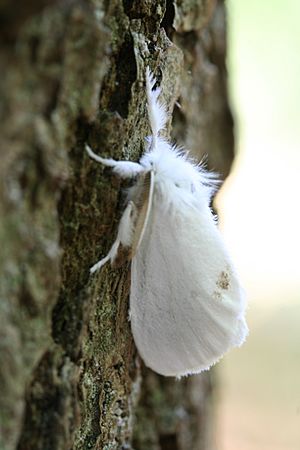Yellow-tail facts for kids
Quick facts for kids Yellow-tail |
|
|---|---|
 |
|
| Scientific classification | |
| Synonyms | |
|
The yellow-tail moth (also known as the goldtail moth or swan moth) is a beautiful white moth. Its scientific name is Sphrageidus similis. This moth belongs to a family called Erebidae. It was first described by Johann Kaspar Füssli in 1775. You can find these moths across Europe, all the way to the Ural Mountains, and even further east into Siberia, India, and Sri Lanka.
Physical Appearance
This moth is usually 35 to 45 millimeters wide when its wings are spread out. Female moths are often a bit bigger than males. Both male and female moths are pure white. The only color is a bright yellow tip on their abdomen, which is larger on the female. Male moths also have a small black or brown mark on the lower corner of their front wings.
Sometimes, especially in males, you might see small dark spots on their front wings. Some have three spots near the inner corner, while others have just one. These spotted moths are more common in eastern Asia than in Europe.
Life Cycle and Habits
Yellow-tail moths fly at night during July and August. They are often attracted to lights, especially the males.
Caterpillar Stage
The caterpillars of the yellow-tail moth are black with some grey hairs. They have a red stripe down their back and white stripes on their sides. Their head is black. The caterpillars usually eat leaves from trees and shrubs. Some of their favorite plants include alder, apple, birch, blackcurrant, blackthorn, cherry, chestnut, hawthorn, oak, rowan, and sallow. They have also been seen eating monkshood, which is a type of plant that grows from the ground.
Overwintering and Pupation
These moths spend the winter as caterpillars. After hatching from their eggs, the tiny caterpillars spread out. The female moth covers her eggs with yellow hairs from her own body. The caterpillars then hibernate alone during the cold months. In early June, they change into a pupa (a resting stage). The pupa is dark brownish-black and is found inside a whitish cocoon.
Yellow-tail moths are common in the areas where they live. They are not usually harmful to plants, unlike some other similar moths. When a yellow-tail moth is resting, it folds its wings steeply, like a roof. If you touch it, it might pretend to be dead by lying on its side with its wings closed.






